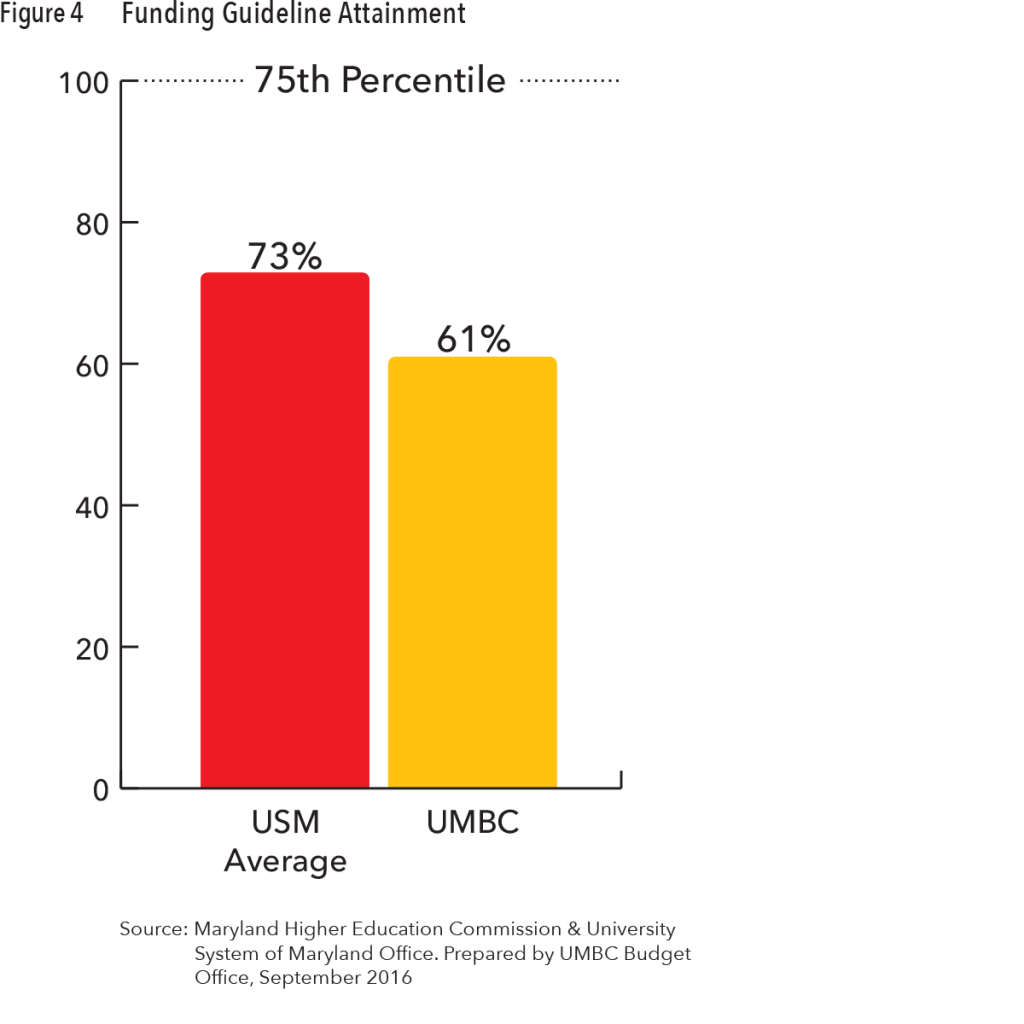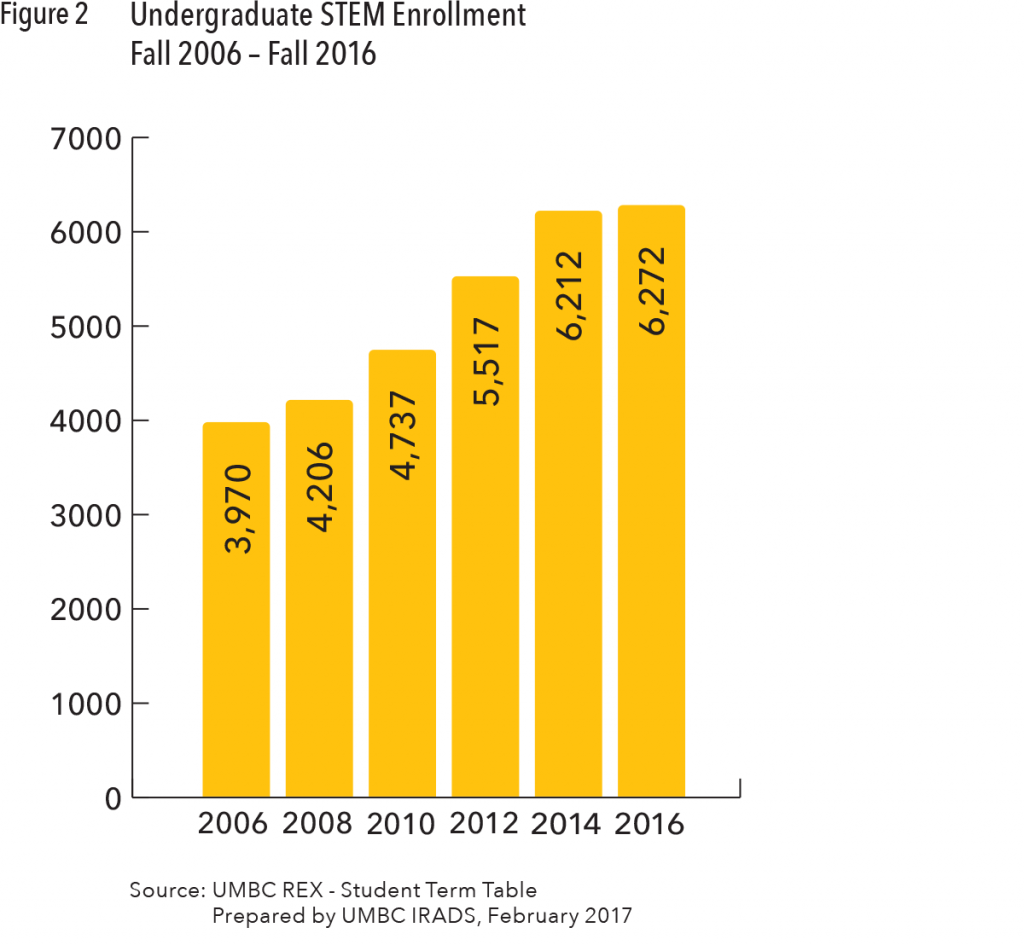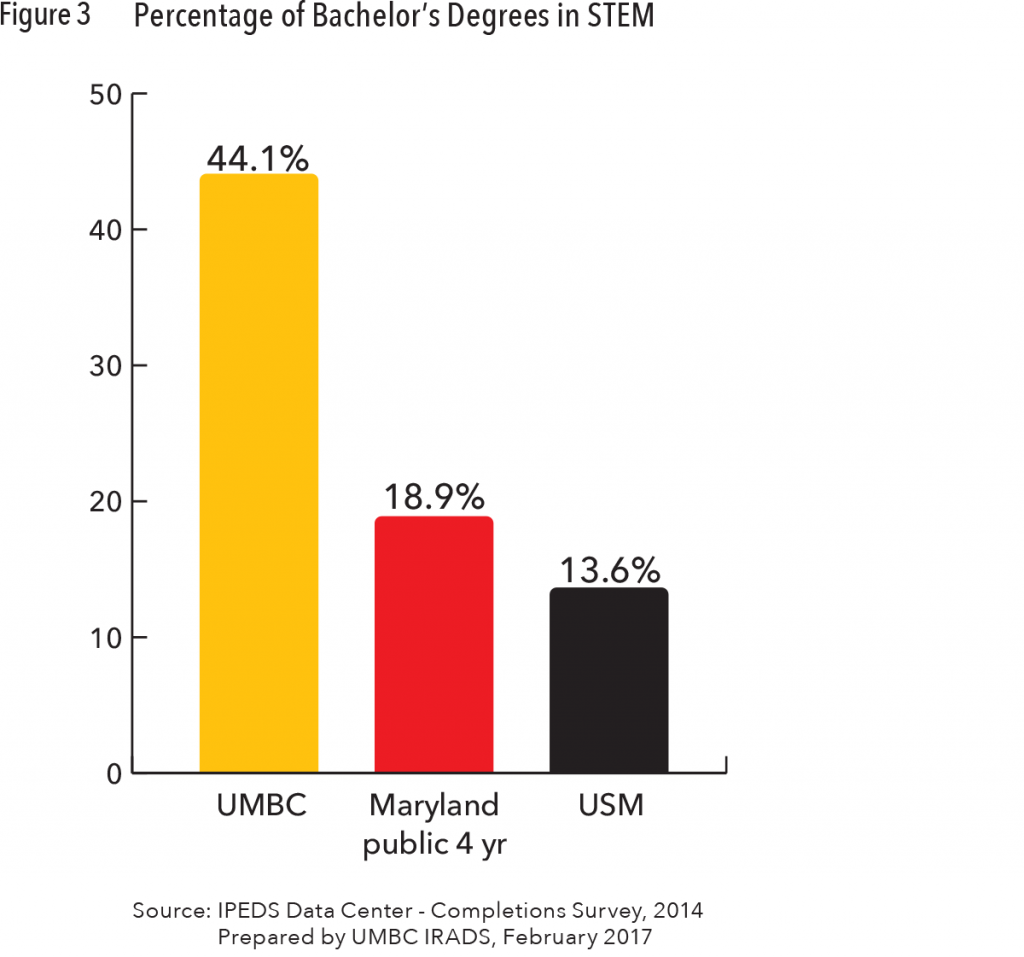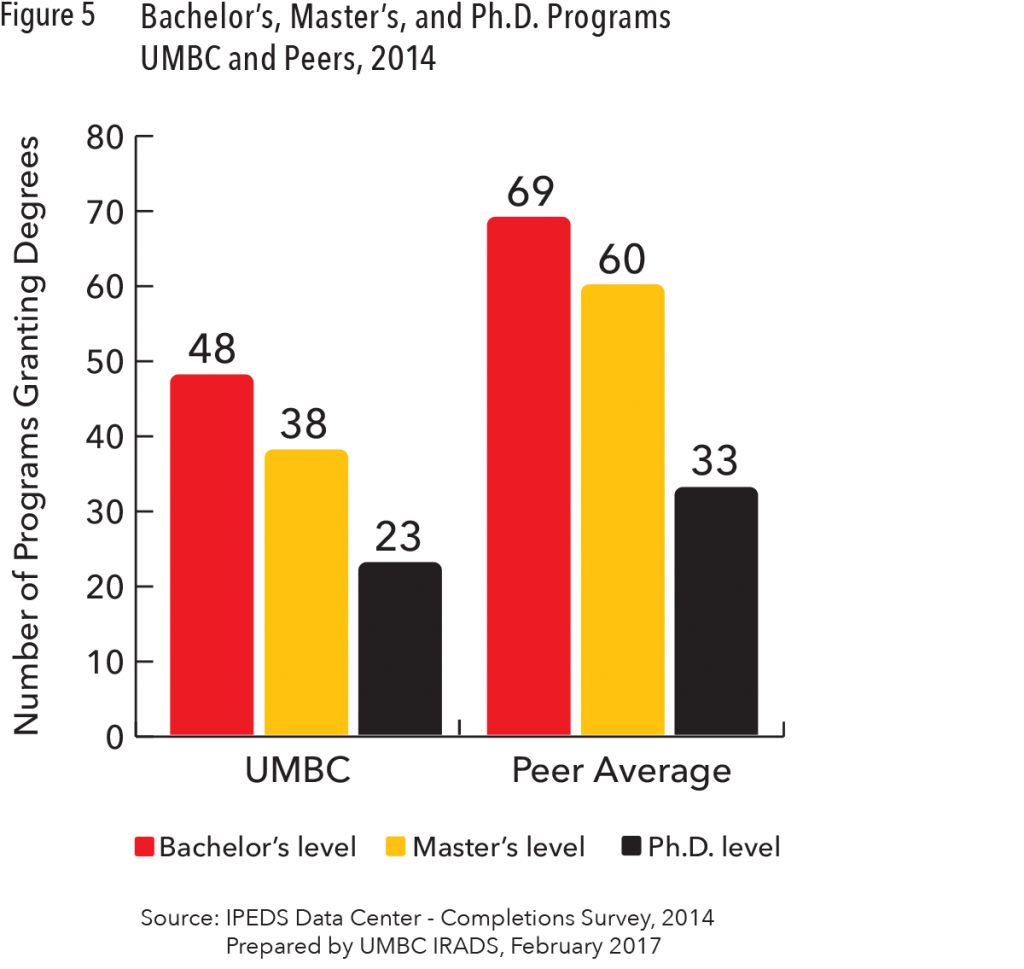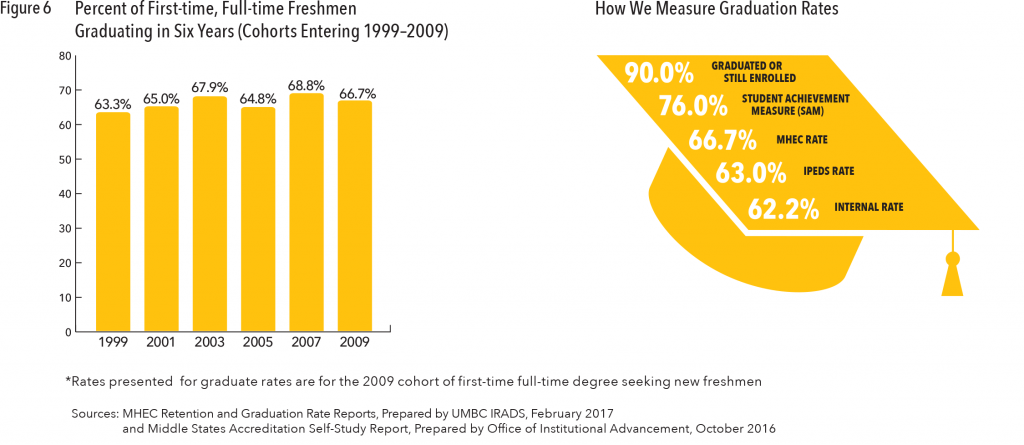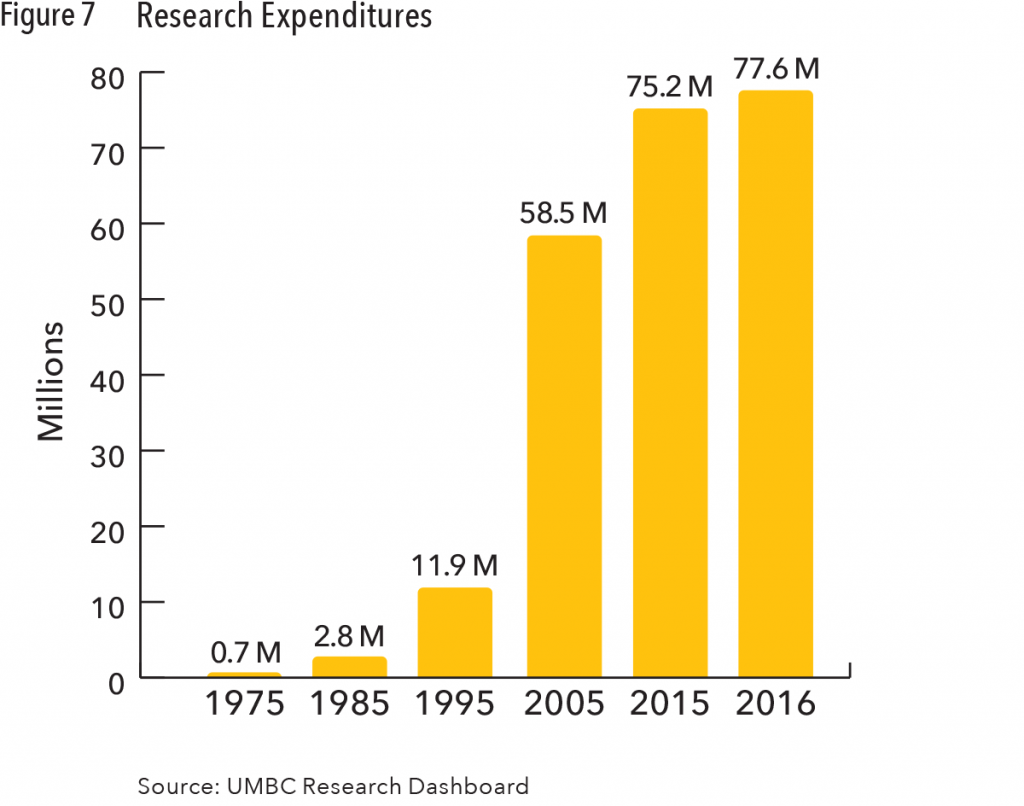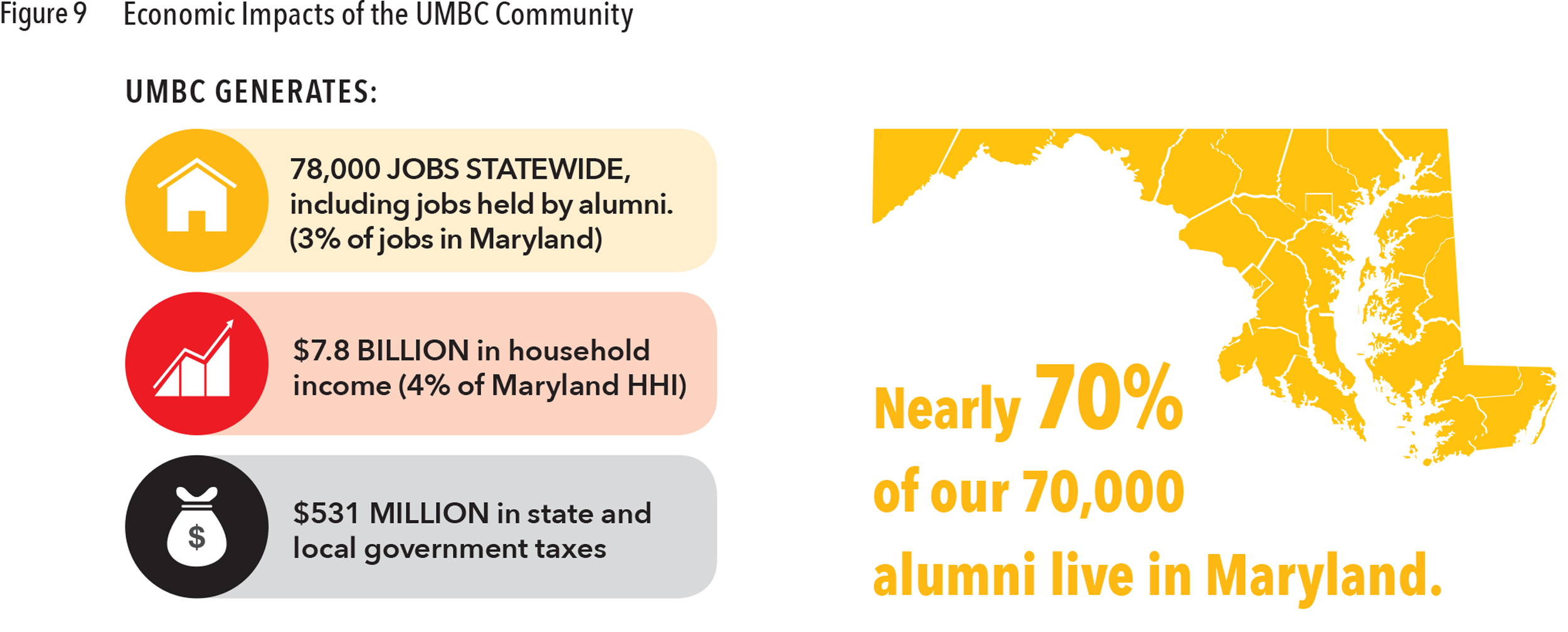University of Maryland, Baltimore County (UMBC)
FY 2018 Legislative Testimony
Freeman A. Hrabowski, III, President
February 2017
This is a special time in UMBC’s history as we celebrate our 50th anniversary. Our progress over the past five decades has not always come easily, but with hard work and an unfailing commitment to our values, we have created a community that is known nationally for inclusive excellence and that transforms lives. Our anniversary theme is “Grit and Greatness,” and we know that our achievements are built on the steady support of our State leaders, who through many financial challenges continue to make access to quality higher education a State policy priority.
On behalf of our students, faculty, staff, and alumni, I want to thank you for your continued support of both UMBC and higher education in Maryland.
I urge you to support Governor Hogan’s full budget request for the University System of Maryland, which balances goals we all share for affordability, degree completion, and effectiveness and efficiency in public higher education.
Our campus is very concerned, however, by the language in the Governor’s Budget Reconciliation and Financing Act (BRFA) that would delay implementation of the $4 million in the funding guideline attainment section of last year’s SB 1052 until fiscal year 2019 and by the change in language from “shall” to “may” in whether this funding is included in the Governor’s budget in subsequent years. UMBC has been challenged by its low State funding level and we were greatly encouraged by passage of this law during the last legislative session.
At 61 percent, UMBC ranks at the bottom of the USM in funding guideline attainment—well below the USM average of 73 percent. This resource gap restricts our ability to grow enrollment in critical areas of State workforce need and provide courses students need to graduate in a timely way, particularly in expensive STEM programs.
Exceptional Return on Investment
We know that the State’s commitment to higher education comes with expectations of accountability, and I am delighted to be with you today to talk about the return on your investment in UMBC.
UMBC just had its 10-year accreditation site visit by the Middle States organization. The visit was preceded by a rigorous campus self-study that included a review of our mission and goals and a thorough institutional assessment. After reviewing our self study report and spending three days meeting with students, faculty, and staff on our main campus and at Shady Grove, the Middle States review team immediately reported that UMBC met all standards for accreditation and that they had no additional recommendations. We just received written confirmation of this extraordinary report and the review team notes, “UMBC should be commended for the degree to which its various plans—academic, enrollment, facilities, research, and most important, financial—are interrelated. This is a sign of effective institutional planning.” The evaluation is, by far, the most favorable and complimentary assessment I have seen in my years in higher education.
We have also recently received a report on the economic impact of UMBC from Sage Policy Group. The report details the impact of UMBC and our alumni over the past five decades. We are proud to note that the total economic impact created in Maryland by UMBC is in the billions, derived from the direct and indirect employment produced by the University, our bwtech@UMBC Research and Technology Park, current students, and alumni.
UMBC was founded at a time of great expansion in access to higher education. When we opened our doors in 1966, we had a special place in this expansion as the first university in Maryland to welcome students of all races and backgrounds. We have been an “experiment”—a place for all students to participate equally in higher education, preparing them for meaningful lives and careers and working to solve the problems of society.
Our story speaks to the power of public higher education to strengthen our State and to prepare the next generation of citizens. Over the years, the achievements of our graduates have represented the success our nation envisioned when we opened our doors. Our alumni network is now over 70,000 strong, with the majority living and working in Maryland. Our graduates serve in the State, the nation, and the world in professions including medicine, law, science and engineering, teaching, public policy, social work, and the arts.
But success is never final, and we continually seek to improve.
Success with Students
UMBC is on track to meet its college access and completion goals as outlined in the USM strategic plan.
Over the past decade, our campus has significantly expanded enrollment, including freshmen, transfer students, graduate students, and students in noncredit courses. Over the past decade, fall headcount enrollment increased by 15.6 percent, from 11,798 to 13,640 students. The growth comes despite a drop off in enrollment nationally with the waning of the Baby Boom echo. The slight decline in enrollment from 2014-2016 is due to increased success in student degree completion and enrollment capacity pressure in computing majors.
In addition to those nearly 14,000 students, UMBC serves students in summer and winter programs, the English Language Institute, and the UMBC Training Centers, for a total of about 20,000 students overall.
Our student body continues to reflect the diversity of the young people in Maryland. This year, 16.4 percent of our students are African American, 18.7 percent are Asian American and 6.5 percent are Hispanic or Native American. At the undergraduate level, 49.3 percent of our students identify in minority race/ethnicity groups.
We continue to widen the STEM workforce pipeline crucial for Maryland’s economic growth. UMBC excels at helping students of every background graduate in demanding STEM majors. Enrollment in STEM majors has increased 58 percent over the past decade, greatly outpacing UMBC’s overall enrollment growth of 18 percent in the same period. In fall 2016, STEM majors account for 56 percent of enrollments. At just over 44 percent, UMBC has a higher percentage of STEM bachelor’s degree recipients than any other public Maryland institution.
The enrollment growth we have experienced in recent years and increased retention and completion rates are all the more noteworthy because of our narrow program base. UMBC offers a smaller number of bachelor’s degree programs than its peers. As a result, it costs us more per student to increase enrollment because we have a smaller proportion of relatively low-cost programs to balance more expensive STEM majors. In addition, offering a broader range of programs would likely increase retention and graduation rates because students would be able to pursue the majors they want without having to transfer from UMBC.
UMBC is pursuing a number of strategies to maintain robust enrollment across our existing and planned new academic programs to ensure our contribution to Maryland’s workforce and economy remains strong. We continue to expand our student success initiatives, including creating new degree pathways and transforming courses based on new knowledge about student learning. We are reaching out to prospective students in a variety of ways to increase the numbers of admitted students who decide to come to UMBC. New programs and expansion of existing programs at the Universities at Shady Grove are also a part of our strategy. A number of new professional master’s programs are in development to address workforce needs in such areas as Data Science, Technical Management, Entrepreneurship and Innovation, Biostatistics, Integrated Product Design and Manufacturing, and Translational Life Sciences at Shady Grove.
The proportion of our first-time, full-time freshmen who graduated from UMBC or another Maryland public institution within six years was nearly 67 percent for the latest cohort. National Student Clearinghouse data show that 76 percent of our students completed their degrees at any U.S. institution within six years, and another 15 percent of those students are still enrolled in postsecondary education. This means that after six years, 90 percent of the individuals who started college at UMBC have graduated or are still actively pursuing degrees.
Using data analytics to track student engagement and performance is critical to increasing student success. Last year, UMBC added two new predictive analytics products to reinforce our current efforts. One tool supports analysis of course demand and scheduling to better meet students’ course needs. A second tool provides us with a variety of analytics on student learning and course design to better measure the impact of interventions to support student success. Both tools serve to more effectively and efficiently move students through their college experience to degree completion.
Our work with community colleges in Anne Arundel, Howard, Montgomery, and Baltimore counties through our STEM Transfer Student Success Initiative continues to be highly successful. The program, sponsored by the Gates Foundation, helps ensure that STEM students who transfer from community colleges are well-prepared to transition to UMBC and receive the support they need to succeed once they are enrolled. Last year, our STEM transfer students graduated in the same proportion as transfer students seeking degrees in non-STEM fields.
Our innovative approaches have brought UMBC national recognition. For several years, US News has ranked UMBC as a leader in both innovative teaching and undergraduate education.
UMBC Research — Growth Aligned with State Priorities
In the report, UMBC at 50: Momentum and Impact, Sage Policy Group noted, “UMBC has had remarkable success in capturing funds for research over the decades.” Fifty years ago, the funding for research at UMBC was less than $1 million per year. Today, we are a thriving research university with nearly $80 million in research expenditures in areas that build Maryland’s economy. UMBC is classified by the Carnegie Foundation as a Doctoral University – Higher Research Activity, and Times Higher Education has twice named UMBC as one of the world’s top young universities for strong research, innovation, and a global outlook.
Our areas of research growth are well aligned with the State’s priorities – environmental sciences, Earth and space sciences, cybersecurity, big data and cognitive computing, health disparities, health technologies, life sciences, policy studies, digital arts, digital humanities, and education. Our most successful, impactful research efforts are based on collaborations across the campus, with other academic institutions, and with government partners.
UMBC and the University of Maryland, Baltimore (UMB) have a longstanding partnership that has expanded further in recent years. We share a number of facilities, including the Center for Brain Imaging Research and a Nuclear Magnetic Resonance Core Facility. We also partner to provide joint graduate programs in biochemistry, molecular biology, gerontology, and the undergraduate social work program. Faculty are collaborating on a number of powerful initiatives, ranging from research related to rapid cholera detection to developing a non-invasive respiratory monitor, to creating a dental implant that generates energy. Our UMBC-UMB Research and Innovation Partnership Seed Grant program, designed to promote and enhance inter-institutional research collaborations and stimulate joint grant proposals to federal agencies and foundations, just completed its third year. Fourteen Partnership Seed Grants, which support 32 faculty at both institutions, have been awarded since 2013.
UMBC is ranked among the top 20 universities nationwide in NASA funding. In June 2016, NASA renewed its support for the Goddard Planetary Heliophysics Institute (GPHI) for up to $20 million over five years. The Center, led by Dr. Jan Merka, seeks to understand physical processes related to the Sun and interplanetary spaces in our solar system, such as how the magnetic field surrounding Earth protects us from solar wind, which has the potential to damage our power grid. GPHI is a joint venture of UMBC; the University of Maryland, College Park; and American University, further building our institutions’ capacity for robust, impactful research collaboration.
UMBC has become an internationally respected leader in cybersecurity. Building on our founding partnership with the Federally Funded Research and Development Center for Cybersecurity, we have established numerous new collaborations with the federal government, private sector and international partner organizations. We have established several multi-year cybersecurity research collaborations with the U.S. Naval Academy and have recently become the first Maryland campus with a Naval ROTC program.
In 2016, IBM selected UMBC as one of just eight institutions in the country to work on training the famous IBM Watson cognitive system. IBM donated $1 million to launch UMBC’s new Accelerated Cognitive Cybersecurity Lab. Our cybersecurity work and strength across disciplines, from engineering to mathematics to the arts, are also being recognized on the international scene through meaningful partnership agreements with Kyushu University in Japan, IIT Delhi in India, the University of Kassel in Germany, Tel Aviv University in Israel, and the University of Porto in Portugal.
Researchers at UMBC’s Center for Urban Environmental Research & Education (CUERE) are working to develop a better understanding of the environmental, social, and economic consequences of changes to the urban landscape. In 2015, UMBC became a partner in the Urban Water Innovation (UWIN) network, a national consortium of universities with $12 million in NSF support that serve as innovation centers to address challenges that threaten water systems in Maryland and around the world. The director of CUERE serves as associate director of UWIN, which takes advantage of UMBC’s strengths in stormwater management, green infrastructure, water quality control, urban flood dynamics, and urban biodiversity.
We are also working hard to protect one of Maryland’s greatest assets, the Chesapeake Bay.
Dr. Lee Blaney, professor of chemical, biochemical, and environmental engineering, is focused on the detection, fate, and transport of contaminants of emerging concern (CECs), such as pharmaceuticals, personal care products, hormones and antibiotics, which find their way into our water supplies and often go untreated.
Economic Impact
The economic development impact of UMBC research is perhaps best described by our successful participation in the TEDCO Maryland Innovation Initiative (MII) program. Since the launch of the MII program in November 2012, UMBC faculty have secured a total of 25 awards, valued at over $2.4 million-second only to Johns Hopkins University. UMBC has become one of the strongest contributors and beneficiaries of the TEDCO MII program. Faculty start-up companies include Octava, an iPad application that provides informative background information for audiences during live performances; Tarsier Optics, a new approach to create light-weight lenses for very high-resolution digital photographs; and a set of new sensors to recognize gestures made by people with limited mobility, so they can control their own environments.
We continue our work to build an ever-stronger entrepreneurial ecosystem in the State. Our research and technology park, bwtech@UMBC, is home to 1450 workers and supports over 3000 jobs in the State. In their recent report, Sage Policy Group concluded that the research park’s total contribution to Maryland’s economy totals $340 million per annum and the tax revenues exceed $10 million. bwtech@UMBC also houses 150 companies, 50 of which are cybersecurity companies mostly located in our cyber incubator. This represents one of the largest clusters of early-stage cybersecurity companies at a university-affiliated park in the nation.
The total economic impact of the UMBC community is significant. Statewide impacts are estimated at over 77,000 jobs (3% of the total number of jobs in the State), with annual income of $7.8 billion (4% of the State’s total annual household income). The ongoing growth of the university, bwtech@umbc, and the ever-expanding population of UMBC alumni means that this impact will continue to expand as UMBC enters its second half century.
Partnerships Across Maryland
Addressing today’s biggest challenges requires flexibility and partnership, and nimble collaboration is part of UMBC’s DNA.
Our longstanding partnerships with the National Security Administration (NSA) and Social Security Administration, as well as private sector companies including Northrop Grumman, T. Rowe Price, and Lockheed Martin, continue to build the State’s economy and workforce.
UMBC’s unique summer fellowship program, SciArt, funded by the Andrew W. Mellon Foundation, develops students’ science expertise while encouraging their appreciation for the arts and humanities. Students work on research projects with specific art conservation applications at the Walters Art Museum under the guidance of faculty from UMBC and Johns Hopkins University. Interdisciplinary programs such as SciArt prepare students for a widening range of possible career paths, helping to address the challenges and opportunities presented by an evolving career landscape that emphasizes teamwork and creative problem-solving.
One of our newest programs, Baltimore RISE (Regional Impact through Sector Engagement) places UMBC students, from a variety of majors, in government and nonprofit internships. The students attend seminars exploring nonprofit and government sector careers and engage in cross-sector work. Students also work in pairs to research an issue related to their internships that impacts the Baltimore region and propose a cross-sector solution to address the issue.
UMBC’S contribution to the State goes beyond preparing our students for the workforce and building the economy through research and tech commercialization.
We partner with K-12 educators in major jurisdictions across the State to increase achievement, particularly in math and science. Our partnership with Lakeland Elementary Middle School in Baltimore City, for example, has generated $4 million in additional investment in the school over the past 5 years, including funds we have raised for this effort from philanthropists George and Betsy Sherman and from Northrop Grumman.
The longstanding UMBC Choice Program partnership with the Department of Juvenile Services saves the State $11 million annually by providing intensive community-based case management for youths in Baltimore City, Baltimore County, Prince Georges County, and Montgomery County who would otherwise be sent to juvenile facilities.
Through more than two decades of partnership with the Department of Health and Mental Hygiene, UMBC’s Hilltop Institute provides sophisticated data analytics to Maryland Medicaid, the Maryland Health Services Cost Review Commission, and other State healthcare programs to support more effective management of healthcare quality and cost. Many states come to UMBC to inquire about how they can replicate The Hilltop Institute.
Financial Stewards
UMBC is focused on being a responsible steward of the resources entrusted to us. In the past fiscal year, we realized more than $7.7 million in savings and avoided costs as part of our participation in USM’s Effectiveness & Efficiency Initiative. For the past five fiscal years, UMBC has achieved a total of $21.3 million in efficiencies, of which 61% ($13 million) represents savings achieved through energy conservation programs, competitive contracting, and technology initiatives.
We have fared well on legislative audit, USM internal audits, and financial statement audits. For the most recent legislative audit we had no repeat findings, and also zero information systems findings. The recently completed FY 2016 annual financial statements and A-133 audits were also clean with no findings.
In addition to the high priority we place on financial aid for students from low-income families, we are mindful of the financial worries that come with attending college for many students and their families. Our Financial Literacy and Education Committee (FLEC) has established a dedicated website, course modules for undergraduates, social media presence, and financial literacy workshops to teach our students how to finance their education and manage what they earn and owe after graduation.
Summary of FY 2018 Budget Request
Operating Budget
The Governor’s proposed FY2018 budget recommends a budget authorization for UMBC of $448.6 million, a 3% increase over the FY2017 adjusted working budget. The FY2018 authorization includes an additional $5.6 million (or 4.8% increase) in State funding and a $2.1 million increase in tuition and fees. The Governor provided $2.3 million of the $5.6 million in new State funding specifically for tuition relief, allowing the campus to hold its FY2018 tuition increase for in-state undergraduate students to 2%.
The additional State funding also includes $3.5 million to begin addressing UMBC’s low funding per student compared to our competitive peer institutions. This supplementary funding, mandated by Senate Bill 1052 enacted during the 2016 legislative session, will increase funding guideline attainment for UMBC from the current 61% to 63% of the 75th percentile goal, an important step in funding UMBC at a competitive level. This funding will allow UMBC to provide the courses our students need to make more timely progress toward their degrees, to continue to build academic programs that align with State workforce needs, to invest in research and economic development activities, and to provide appropriate infrastructure and services. If the Budget and Financing Act of 2017 as introduced is enacted, this additional funding will be cut from UMBC’s budget and make it impossible for us to achieve these important goals.
It is important to note that the FY2017 working budget sustained a $1.27 million mid-year base reduction, which was carried over into the FY2018 proposed budget, partially offsetting this improvement in funding.
We would ask that, should a supplemental budget be possible, the legislature consider further investment in UMBC and other USM institutions, to build on our proven track record in advancing the State economy and quality of life.
Capital Budget
UMBC’s FY 2018 budget request of $60 million provides for continued construction and equipment outfitting of our Interdisciplinary Life Sciences Building. With a final allocation of $48 million in FY 2019 funding, the new building will be completed in time for the Fall 2019 semester. The new Interdisciplinary Life Sciences Building will seamlessly connect teaching and research activities to enhance and further stimulate collaborative approaches to advancing the State’s biotechnology industry and increasing the number of STEM graduates. Approximately eight new active learning classrooms, four seminar rooms, four multi-disciplinary teaching labs, a good manufacturing practice facility, and collaborative project team rooms will support an additional 1,800 FTE STEM students. Flexible and adaptable research labs and core facilities will provide opportunities for as many as 45 principal investigators and their graduate assistants and undergraduate students opportunities to engage in interdisciplinary research focused on advancing the State’s biotechnology industry.
Responses to Legislative Analyst’s Questions
Page 3: USM Overview — System-wide recommendations
1. Reduce USM general fund appropriation by $16.6 million.
The DLS analysis states that new State-supported revenues are more than sufficient to cover Current Services Costs. Based on our preliminary budget planning, UMBC will have an almost $2 million shortfall in FY2018 in our State Support budget. Even as we continue to try and find cost savings and cost avoidance as part of our Effectiveness and Efficiency efforts, it will be very difficult to avoid making painful cuts in the coming year if we have an additional reduction of this magnitude. The DLS recommendation suggests that campuses could reduce their planned transfer to fund balance in order to absorb this reduction. Over the last decade, UMBC has focused on building up what was a woefully inadequate fund balance when compared to a variety of benchmarks. To create minimal flexibility in responding to emergencies and opportunities, we have postponed significant infrastructure and facilities renewal projects, and other investments. To reduce our planned fund balance transfer as an offset to a State funding cut is a short-term approach that will create long term challenges.
2. Restrict $10 million in State funding for the purposes mandated in Chapter 25 of 2016 (SB 1052).
We are very concerned by the language in the Governor’s Budget and Reconciliation and Financing Act (BRFA) that would delay implementation of the funding guideline attainment section until fiscal year 2019 and by the change in language from “shall” to “may” in whether this funding is included in the Governor’s budget in subsequent years. UMBC has been challenged by its low State funding level and was greatly encouraged by passage of this law during the last legislative session. This additional funding is critical to our ability to provide the courses our students need to make more timely progress toward their degrees, to continue to build academic programs that align with State workforce needs, to invest in research and economic development activities and to provide the appropriate infrastructure and services critical to a research institution. We ask that you reject this section of the BRFA and the DLS language restricting use of the funding. Your State higher education institutions need to have the flexibility to respond to the ever-changing educational and economic environment. These restrictions will hamper our ability to do that.
3. Reduce general fund appropriation for the University of Maryland Environmental Science by $100,000 and restrict $100,000 of USMO general fund appropriation until USM Board of Regents submit a report on the relocation of UMCES to other USM institutions.
UMBC asks the committee to reject these two actions and the underlying proposal to eliminate the University of Maryland Center for Environmental Science. UMCES has strong partnerships with many USM campuses, including UMBC. Its specialized programs offer our graduates an exceptional opportunity to continue their studies and research in one of the most unique and valuable higher education centers in the world. As has been explained in Chancellor Caret’s testimony, breaking apart this institution and embedding those parts in other USM institutions would not result in cost savings.
4. Eliminate the general fund deficiency related to using the fiscal 2016 HEIF balance to partially offset the November 2016 Board of Public Works reduction; and eliminate the general fund deficiency related to providing funds to cover the shortfall in HEIF.
UMBC opposes this recommendation. As the Chancellor pointed out in his testimony, these two actions would result in a reduction in the current fiscal year of $23 million across the campuses and system office. USM has already absorbed $14.2 million in the current fiscal year; UMBC’s share was $1.27 million. The additional cut of almost $9 million would result in UMBC sustaining another FY2017 reduction of almost $900,000. As the committee knows, it is extremely difficult and often much more damaging to sustain a reduction in the latter part of a fiscal year. We respectfully and sincerely request you not accept this DLS recommendation.
Page 6: The President should comment on what UMBC attributes the decline in the number of transfer and continuing students to and what strategies or actions are being taken to stabilize and increase enrollment of all students.
UMBC experienced significant enrollment growth (15.6%) over the last decade and an even larger rate of growth in high-cost/high-demand STEM programs (21.8%) over the last five years. The recent decline is primarily a result of our success in reducing time to degree over the last two years. Larger than usual numbers of undergraduate students entering in fall 2012 and 2013 experienced a shortened time to degree. In fact, up to an additional 100 students have graduated in each of the last two years. At the same time, the number of incoming students in the last 3 years has been lower. This is due in part to over-capacity demand in high cost/high demand programs, where we have been forced to limit the number of new students admitted. We are also limited in our ability to offer financial support to our students. With the additional resources we hope to receive in FY 2018, our intent is to address capacity issues in high demand program areas and to increase support for students with financial needs. The limited program mix at UMBC continues to present a challenge for retention of students looking for majors unavailable to them at UMBC. During this same period, the graduate student population saw a drop, in part due to a decline in county-based teaching cohort and specialized teacher professional development programs due to budget cuts at the local level, which affected our Masters in Education.
Growing enrollment in the coming years is a top priority at UMBC, with a number of specific strategies already underway. Actions have been taken to increase the enrollment of new students in fall 2017 to reach the levels experienced in 2012 and 2013, and to compensate for the impact on undergraduate enrollment levels of an increased graduation rate and reduced time to degree. At this point in the admissions cycle, the number of undergraduate applications for first time freshmen is 4.6% higher than seen for Fall 2016 entry (10,911 vs. 10,430). We are taking steps to capitalize on this record number of applications by undertaking more aggressive yield activities, increasing need-based financial aid, and expanded marketing of non-STEM degree programs where there is capacity. Applications for transfer students have remained very steady with little change in yield, which is partially attributable to the success of the t-STEM transfer partnership with our most significant feeder community colleges. Several new market-based graduate degree programs are under development, and specific efforts are being made to grow graduate programs at the Universities at Shady Grove.
Page 17: The President should comment on the continual shortfall in E&G and what efforts are being taken to reduce costs, thereby decreasing reliance on auxiliary surpluses and vacancies to cover the shortfalls and the impact on student performance of having a high percentage of positions vacant.
While Exhibit 9 on page 16 shows our Education and General Total budget expenditures exceeding revenues, in fact our State Support budget has historically had sufficient revenue to cover State Support expenses, including actual FY 2016 results, and the budget for FY 2017 and 2018. We have reached out to DLS to reconcile the data and to verify our stable financial condition, after receiving the analysis this week.
The position vacancy rate at UMBC is a reflection of managing a number of budget priorities and challenges. Approximately one third of the vacancies are held in order to meet expected turnover savings. The remaining vacancies are fairly evenly spread across faculty, exempt and non-exempt positions. In recent years, the campus has instituted hiring freezes, primarily to address mid-year reductions in State or tuition funding. These freezes often result in use of contractual employees to attend to vital campus operations. In addition, the campus makes an effort where appropriate to employ student workers, giving them valuable job experience. Funding may be moved from vacant lines to support these efforts on a periodic and opportunistic basis. For faculty positions, which are the key to positive student performance, if planned or unexpected vacancies occur among regular full-time faculty, those salary savings are often used to hire part-time or temporary instructors to continue to offer needed courses.
Page 22: The President should comment on the decrease in spending on institutional aid in fiscal 2016 and 2017, particularly the decline in scholarships. The President should also comment on whether the budgeted increase of $0.7 million in need-based aid in fiscal 2018 is sufficient to have a significant impact on increasing FT/FT students. The President should also comment on if consideration is being given to shift funds from scholarships to need-based aid.
The decrease in institutional aid from FY2016 to FY2017 primarily represents the lower amount of UMBC Foundation (donor) funding initially budgeted in FY2017 compared to the amount actually received in FY2016. Our practice is to budget donor funds conservatively, given its variability from year to year. A good estimate of the amount of the UMBC Foundation donor-designated funding is not available until after the budget has been developed. Most importantly, we expect total institutional aid awarded in FY 2017 will be higher than the budget, and comparable to FY 2016 actual awards.
We make an annual assessment each year when deciding how much merit and need-based aid to award. Our first consideration is based on retention of students already receiving scholarships. We make a commitment to first time/full-time students who receive merit scholarships to continue that funding, contingent on maintenance of their GPA, for three more years. The remaining funds are spent on need-based aid. Of our merit scholars, 45.5% had some level of financial need. Of those students, 31.9% also qualified for a need-based grant. Not included in these figures is the estimated $18 million brought in each year from national agencies and private donors to support STEM students, many of whom are first generation with financial needs.
Page 25: The President should comment on financial literacy efforts to inform and guide students in making financial decisions, especially Pell-eligible students, given the relatively low percentage using federal subsidized and unsubsidized loans to pay for college.
The UMBC Financial Literacy and Education Committee (FLEC) was established in 2012 to increase financial literacy awareness and education among new and continuing students. An up-to-date website, linked to a strong social media presence, has hundreds of students accessing financial literacy materials daily. A new incoming student orientation session is centered on financial literacy and uses an original student created video, serving approximately 2,700 students annually. A financial literacy module is provided to the 700-800 students attending the Introduction to an Honors University course. Student-to-student marketing is in place, including an annual video contest and advertising of resources available. Financial literacy workshops are offered to campus groups using talents of our faculty, banking partners and alumni to provide this education. UMBC has successfully competed for two grants from national organizations to support financial literacy efforts for both graduate and undergraduate students. Finally, new policies have created more proactive interventions for students eligible for student loans.
